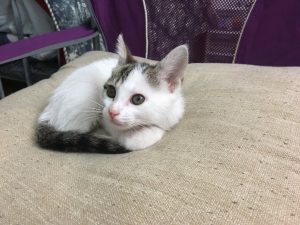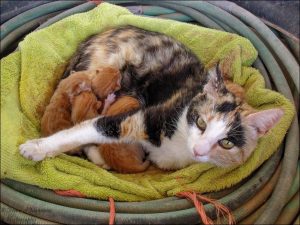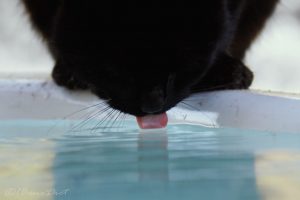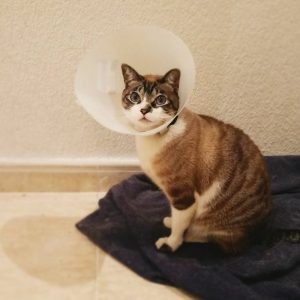What is Neutering and Spaying?
Determining to neuter or spay your felines is a huge decision that you are making for your pet’s health, their welfare, and the well-being of your community. Both procedures are sterilization for cats. For both, your cat will be put under general anesthesia before the surgery begins. It is best to have your kittens (female and male) undergo the procedure before they reach sexual maturity. The best ages to have this procedure done are between the ages of six to eight months old, but this can also be done at four to six months old upon advice from your vet.
Benefits for your Cat
Unless you’re a cat breeder, you’ll want to consider having your cat neutered or spayed. Cats often mate if they are both indoor and outdoor pets, and they will experience behavioral changes due to their hormones. If you have a male kitten and decide that you don’t want the procedure to be done, you and your cat will be at the mercy of raging hormones and you will suffer from increasing frustration on both sides of the relationship. He will spray urine, he will try to expand his territory, he will search for a mate, he will continue to roam or try to escape, and he will likely fight other male cats. If you allow your male cat to be an indoor and outdoor pet, you will be putting your cat’s life at risk if they meet a stronger male. You will also be contributing to the overpopulation of cats if you allow any unfixed cats to roam outside.
When I was four, my parents bought me and my brother cats; I got a black female named Lodica Diamond, and my brother had a male yellow tabby named Yellow Kitty. My parents kept them as outdoor cats and didn’t get the chance to have them neutered and spayed. Because of this, Lodica Diamond had five litters of kittens and Yellow Kitty would often mate with his offspring and other neighborhood females. This resulted in injuries to his face and body. Exactly thirty-eight feral and non-feral cats lived on the property with him.
If you neuter your male cat before they reach eight months of age, you will eliminate spraying for territory; remove the risk of testicular cancer; decrease the chances of prostate cancer; lessen his desire to roam which will make fighting between other male cats less likely; reduce the number of kittens; and decrease aggressive behavior. In the case of females, if you spay her before she’s eight months old, you will stop all heat cycles, resulting in male cats not being attracted; reduce her desire to roam; remove the risk of mammary gland tumors and ovarian and uterine cancer; and also reduce the number of kittens.
Pre-Op Care
Make sure to keep your cat indoors the day before their surgery. Keep plenty of water bowls around the home so your cat can stay hydrated. Your cat must fast for the procedure, so they cannot have any food after midnight. This ensures that your cat’s stomach is empty when they are placed under general anesthesia. If you cat eats after midnight, the chances that your cat will vomit or aspirate the vomit into their lungs in amplified.
The Process of each Procedure
Neutering: after your male cat has been placed under general anesthesia, your veterinarian will make an incision in their scrotum. Then your veterinarian will suture closed the blood vessels of the spermatic cord above the testes, and cut the blood vessels that will allow for the entire removal of the testes through the incision. After this, your veterinarian will check the blood vessels for bleeding, and they will release the knotted end into the incision. Afterward, your veterinarian will close the skin layers with sutures that will dissolve.
Spaying: after your female cat has been placed under general anesthesia, your veterinarian will make an incision, mid-line of your cat’s abdomen below the umbilicus, and will then make another incision into the abdominal wall to gain access into the abdominal cavity. After finding the uterus, your veterinarian will follow it to either ovary; from there, they will suture closed blood vessels above the ovaries and cut the vessels to completely remove the ovaries from the Fallopian tube and uterine horn. After this is done, your veterinarian will check the sutured blood vessels for bleeding and release the sutured end back into the abdomen. Next, they will remove the uterus by gently pulling the two sides of the uterus towards the rear end of your cat. They will suture the uterus and its blood supply, and cut the vessels above the cervix to completely remove the ovaries and uterus. Lastly, your veterinarian will again check the sutured blood vessels for bleeding and release the sutured end back into the abdomen, close the abdominal wall with and the skin layers with sutures that will dissolve.
Post-Op Care
After the procedure, your cat will be in pain and discomfort. Your veterinarian should provide you with an Elizabethan cone and give you directions for how to care for your cat. Overall, rules are: do not let your cat jump or run for the first week after surgery because your cat may tear the sutures; do not bathe your cat for at least two weeks after their surgery; make sure your home is peaceful and quiet so your cat can recover comfortably.
Place the cone around your cat’s neck; the cone is meant to prevent your cat from licking the sutures. If your cat does lick their incision site, this can lead to an infection. Check the sutures daily to ensure proper healing. When Mr. Baby Kitty was neutered at seven months old, he would not sit down for a few days after his surgery; this is normal, as some cats don’t want pressure against their suture sites. And when Fredrick Douglass had his surgery at nine months old and had already gotten into the habit of spraying, he was very quiet for a few days, but he stopped being aggressive with the other cats due to the lack of testosterone. If you notice lethargy, diarrhea, a decreased appetite, or vomiting, call your veterinarian and they will probably have you come back to the office with your cat. If there is redness, discharge or swelling at the incision site or if the incision opens, take your cat to your veterinarian or an animal hospital immediately.
Benefits for our Communities
We have an overpopulation issue when it comes to cats, and many people tend to ignore this problem or act as if the situation will resolve itself. Well, overpopulation of cats will not resolve itself. Some cat owners let their cats breed and are able to find a good home for the kittens, but not very many people are dedicated to helping their cat’s spawn find new homes. Most of the time, once a female cat has a large litter, she will become an outdoor cat and will continue to mate with male cats in the area, leading to more litters and contributing to the feral cat population. The ASPCA claims that the estimated number of feral cats is up to 70 million in the United States alone. Sometimes kittens and adult cats are abandoned or just dropped off at local animal shelters. People are more likely to adopt kittens than adult cats that were once feral, leaving them at the shelter for months until they have to be put down to make room for new cats to take their place.
If you plan to be a pet owner, responsibility comes with that and one must accept that amount of responsibility – there is no excuse for not neutering or spaying your cats. If money is a concern, most towns and cities offer low-cost or free clinics, and if you adopt a cat from a shelter, they may have already had the surgery. Let’s help decrease the population of wild kittens and cats, stop the production of litter after litter after litter, and put an end to the euthanization of cats that people can’t have or do not want.
Elanda-Isabella Atencio, our Feline Editor, is on her road to being a “crazy” cat lady. She has three cats; a moody Missus, a wild Baby Kitty, and notorious Fredrick Douglass. She was raised with cats, chickens, dogs, and geese. From cleaning coops, morning dog runs, picking eggs, to growing catnip, Elanda enjoys pampering her pets. Elanda is a student at New Mexico State University, earning her BA in Creative Writing and is Editor-in-Chief of the online arts journal, Independent Noise and reader for Puerto del Sol. She plans to move to Oregon, where she hopes to take her cats on daily walks when it’s overcast and cool. If you’d like to contact Elanda, email her at eincatencio@gmail.com.






